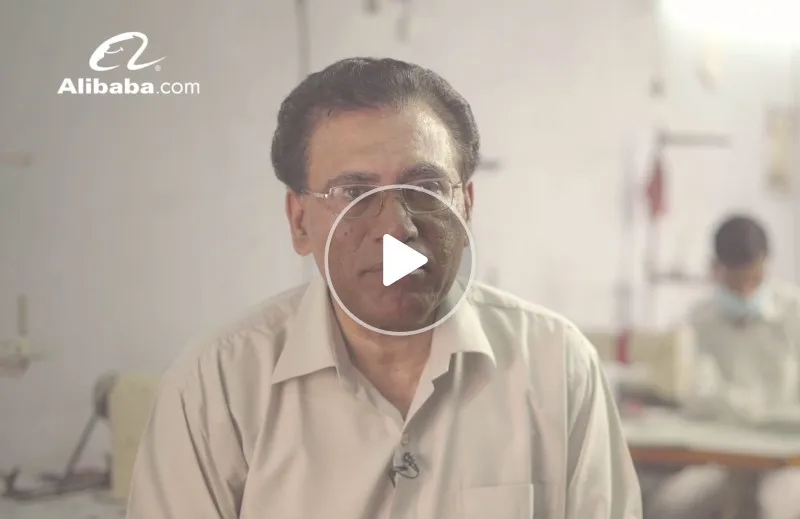How to sell online in India: tips for B2B and B2C sellers

As one of the largest and fastest-growing economies in the world, India is an attractive hub for international trade. The country is also an important gateway to the Asian region, as it shares land borders with seven countries, including China and Bangladesh.
Further, a trend of growing digital penetration in India in recent years has made eCommerce a very lucrative retail option for businesses in the country. This makes India an important trade center for businesses that want to explore import, export, and local selling opportunities in the region.
If you have also been considering the merits of selling online in India, and what this would entail, then this guide is for you. In this article, we discuss the growing profile of eCommerce in India, current trends in online selling, and opportunities to look out for. In addition, you’ll learn important tips to selling both wholesale and retail online in India, and how Alibaba.com supports your success in the country.
Table of Contents
eCommerce and economic growth in India
Although 2020 was a tough year for India’s economy, the country continues to be regarded as one of the fastest-growing in the world. The country’s GDP for the second quarter of the 2019-2020 financial year was Rs. 35.84 trillion ($489.62 billion). This figure fell to Rs. 33.14 trillion ($452.74 billion) in the second quarter of the 2020-2021 financial year1. Despite the slight drop, the country is still on track to become one of the top three largest economies in the world within the next decade.
India’s impressive economic profile is backed by its large and mostly youthful population. The country has a population of over 1.3 billion people, with a median age of just over 28 years. Current projections indicate that by 2025, the country will have more than 1 billion people below the age of 35, with a workforce of roughly 800 million people. Consumption is also expected to triple within that time, rising from $1.4 trillion in 2017 to over $4 trillion by 20252.
All of this points to a steadily expanding market of young, upwardly-mobile, digital natives – the perfect combination for a healthy eCommerce scene.
Although there has been good eCommerce growth in India for several years now, low rates of internet penetration meant growth was sluggish. However, 2020 brought about immense growth for eCommerce in India, with some going so far as to say that “2020 accelerated the eCommerce industry by a decade…”3 Here’s why that was the case.
Impact of COVID 19 on eCommerce in India
While the coronavirus pandemic is widely regarded to have set many industries back, the eCommerce industry has come out in pretty good shape. Reports from all over the world are that 2020 saw a blistering rise in online retail performance4, and the story has been the same in India.
The India Brand Equity Foundation (IBEF) reports that eCommerce grew significantly in 2020, with eCommerce companies reporting online sales of $4.1 billion within the festive period of October 15-21 alone. The country now expects the eCommerce market to reach $200 billion by 2026, from just $38.5 billion in 20175.
This growth has been fueled by the twin influences of rising internet penetration, and the implications of the coronavirus. Internet and smartphone penetration in the country is reported to have increased to 760 million as more people find alternative ways to secure goods and services due to lockdown measures.
This is good news for wholesalers and retailers that have been eyeing a share of the eCommerce market in India. What trends should you be aware of as you plot your entry into the market? That’s up next.
eCommerce trends in India
With the increase in online shoppers exploring digital marketplaces and storefronts, eCommerce businesses in India are having to evolve their operations by the day to keep up with demand. Here are some of the trends shaping this demand:
- m-commerce: Unsurprisingly, mobile commerce (m-commerce) has become an important trend. A majority of online shoppers are accessing goods and services through mobile apps and browsers, meaning retailers must intentionally position their stores for mobile visitors.
- Omni-channel retailing: Although online shopping has grown massively in 2020, many people still enjoy visiting their local stores. Businesses are providing multiple sales channels for buyers, both digital and in-store, to stay on top of this trend.
- Drop-shipping: As we will explain below, drop-shipping is a convenient option to connect consumers with goods. Current trends indicate this is an increasingly popular option for both buyers and sellers.
- Personalization: Research indicates that 88% of marketers find that customers want a personalized experience6. They want selling channels and payment options that are suited to their circumstances.
- Automation: With the rise in the use of chatbots, automated calling, and real-time order tracking, automation is another trend that is shaping demand.
Import-export opportunities for SMEs and startups in India
With the increasing profile of the country as an international trade destination, the Indian government is actively supporting the capacity of local businesses to participate in global trade.
Small and medium enterprises (SMEs) and startups play an important role in the country’s industries. According to data from IBEF, SMEs account for roughly 45% of India’s industrial output, as well as 40% of total exports from the country7. In addition, India is home to more than 21 unicorns (startups valued at over $1 billion), making it the fourth-largest unicorn base in the world8.
This indicates the fertile environment for small and growing businesses in India. Some of the efforts that the government has been taking to help local businesses access the global market include:
- The “Make in India” scheme, which encourages local production for local and global consumption.
- The India Foreign Trade Policy, which introduced incentives such as tax cuts on exported goods.
- Digitization of Indian Customs to enable free flow of goods.
- Advance Authorization and the Duty Drawback Scheme, which provide refunds on duties and duty-free import of goods used to manufacture export goods9.
📌Read more:
Import and export opportunities
There’s a wide variety of products that you can consider selling online in India. Thanks to the low cost of labor and a plenitude of natural resources, it is relatively inexpensive to start producing and exporting these goods. Some of the available options include:
- Personal protective equipment: Although significant progress has been made in the development and distribution of vaccines, COVID-19 is still a global concern. Masks, gloves, and overalls are in steady demand all over the world, and with the rate of infections spiking recently, there’s a lot of opportunities here.
- Hand sanitizers and hand wash: The demand for alcohol-based hand sanitizers and hand wash also presents a significant opportunity. A common complaint of consumers is the need to moisturize their hands after using these products. There may be a lucrative opportunity for businesses that can find a way to provide products that both disinfect and moisturize.
- Clothing: India is home to one of the largest textile and apparel industries in the world10. While the global demand for clothing is evolving as people still experience restrictions outdoors, the increasing pace of vaccination should encourage higher demand.
- Pharmaceuticals: Global health is currently experiencing a crisis of never-before-seen proportions. Apart from COVID-19, several health issues ranging from cancer, to diabetes, and respiratory diseases have been on the rise recently. To meet these issues head-on, healthcare providers will require a steady flow of medication and ancillary devices.
- Spices: With people enjoying more free time than ever before, many are turning to cooking as a way to engage themselves. This is creating opportunities for businesses in the food and spices verticals. India is an active participant in the global spices market. Between April to August 2020, the total value of spice exports from the country was $1.5 billion11.
- Jewelry: India also enjoys its share of jewelry exports. There is a thriving trade in gold, copper, garnet, and diamonds, with popular export destinations including countries such as Japan, China, and the US.

Countries you can export to
India has forged strong trade relations with multiple countries around the world, including the US, UAE, China, UK, and the EU region. The US is India’s largest trading partner – exports from India to the US totaled roughly $57.7 billion in 201912.
Other top export destinations from India include the UAE and China, which enjoyed export volumes of $29.7 billion and $17 billion respectively. The UK is also a strong trading partner with India, with India ranked above China, Hong Kong, and Singapore on the list of the UK’s trading partners13.
In addition to this, the Indian government is also actively exploring further trade partnerships in newer markets. This includes plans to set up trade promotion bodies in 15 countries. That said, we’ll look next at tips you can put to work in positioning your business to sell online in India, whether via exports or on the local scene.
Tips for selling online in India as a B2B supplier
When selling online, there are multiple concerns that a B2B supplier will need to consider. If you do not already have a product selection, you must consider what products to sell, then who to sell to, and how to sell. Here are a few tips that can help as you go about making these decisions.
1. Selecting a product range
There’s quite a range of products you can sell as a B2B supplier. You can start with products that might be considered input materials or semi-finished materials for other goods. Examples include chemicals such as ethanol, carbomer, and isopropanol for hand sanitizer. Conduct a bit of market research to identify those who fit your target market, how they are likely to buy, and what they may want to buy.
After selecting a product range, think about how you want to source inventory. You can decide to sell established brands by either becoming an authorized distributor or approaching an existing distributor to resell. It can also be a good idea to look for generic suppliers abroad, then import and package the goods yourself. Just try to target products that either have a relatively short input supply chain, or that have local suppliers. This helps you avoid the risk of future disruptions like what COVID-19 has caused.
2. Choosing a business model
As a B2B supplier, your customers likely want to have full confidence in the legitimacy of your business. This means it may be in your best interest to register as a private company. This gives you the formality of a limited liability company structure, and encourages trust in your ability to handle large or repeat orders.
To register a private company, you must be prepared to meet the necessary regulations. This includes obtaining a Permanent Account Number, registering for Goods and Services Tax Identification Number, and securing the necessary incorporation documents14.
3. Pricing your products
Product pricing will likely form an important part of your initial tasks as a B2B supplier. Selling wholesale comes with its own unique concerns, since you must set a price that leaves enough of a margin for your customers to make their own profit. Your price must also be sufficient to allow you to cover all of your costs and enjoy a tidy profit.
💡Check out our extensive guide on how to determine wholesale pricing for strategies you can apply to solve this challenge and formulas you can use.
4. Finding buyers for your product
With a clear idea of what you want to sell, you should also know how you intend to sell. The available options include creating your own eCommerce storefront or registering on an established marketplace. If you decide to create your storefront, you must think about buying a domain name and creating a website, as well as digital marketing and SEO strategies to attract buyers.
But with an online marketplace such as Alibaba.com, you don’t need to worry about attracting buyers. You can reach millions of serious B2B buyers, both in India and around the world, who are interested in your products.
5. Finalizing logistics
Logistics includes the end-to-end process involved in getting products from your store and into the hands of customers. Obviously, if you intend to supply foreign customers this process will be longer. Online marketplaces like Alibaba.com will assist with a built-in platform where you can engage with clients, confirm orders, finalize them, receive payment, and ship the products.
If you decide to open your own eCommerce website, you must take care of these by yourself. International parcel forwarding services such as FedEx and UPS can help here.

Tips for selling online in India for B2C sellers
With B2C sellers, the potential market is a lot more fickle, with tastes that may change at a moment’s notice. Online B2C customers are not as steady as B2B customers, since they often have many more sellers trying to market the same goods to them. This means you must take the time to find a product, and a selling structure, that keeps customers coming back.
1. Identifying your selling model
One of the popular selling models that have risen to popularity in recent times is the drop-shipping model. With drop-shipping, you essentially maintain only an online storefront. Customers view the products they would like and place orders. Then you source the products from a third-party supplier that handles delivery to the buyer, at your direction.
The advantage of drop-shipping is you don’t have to maintain any inventory. This can significantly cut your operating costs, and potentially allows you to enjoy higher margins. But the disadvantage is you may find yourself in a tight spot if your third-party supplier disappoints.
Apart from drop-shipping, you may also explore the pure retail selling model. Here, you maintain your own inventory, which means you can provide goods instantly and don’t have to wait for them to get shipped.
2. Finding buyers
Just like with B2B businesses, you should decide if you want to create your own online storefront or team up with an established marketplace like Amazon. No matter what you decide on, keep in mind that you need to optimize for m-commerce. Experts estimate that m-commerce will soon reach 45% of worldwide eCommerce revenue15.
Arguably, an online marketplace lets you save on a large portion of the costs involved in attracting buyers, as well as logistics. However, the tradeoff is you will typically have to pay a percentage of your product revenue as fees or commissions to the platform. But with your own website, you take care of all logistics costs, as well as digital marketing efforts.
3. Pricing concerns
Pricing is not as much of an issue for B2C sellers as it is for B2B suppliers. The most popular method for setting retail prices is the keystone pricing method. Here, you simply multiply the costs of making the goods available by 2 and set the answer as your price. This way, you enjoy a 50% margin on your initial costs.
4. Payments and taxes
You need to adopt a clear policy on taxes. By default, sellers like to include taxes such as Value Added Tax (VAT) in the price of products. Ensure this is made clear to your customers.
If you maintain your own online storefront, take the effort to provide a payment gateway that is swift and frictionless. Failing to do this might cost you in sales. According to reports, 23% of customers abandon their cart due to an unnecessarily long or complicated checkout process16.
However, there’s one thing you should keep in mind. Most Indian customers prefer to pay in cash, even though digital payments are growing in acceptance. This means you may need to provide a “pay on delivery” option, at least until digital payment becomes fully mainstream.
Alibaba.com for Indian B2B wholesalers, manufacturers, exporters
Clearly, there’s a lot to think about after taking the decision to sell online in India. While the process certainly isn’t easy, you can trust Alibaba.com to be your reliable partner as you start your business, scale, and grow to reach the success you desire.
Like many aspiring Indian entrepreneurs, Vinod Katyal started selling on Alibaba.com to reach a global audience and sell to customers all around the world. He founded KVR Intexx in 1999 to help businesses meet their small-order needs with products sourced from India.
He started selling on Alibaba.com in 2004, and since then, has seen his business enjoy tremendous growth. Today, Vinod’s business benefits from Alibaba.com’s presence in more than 180 countries around the world, and he is in touch with buyers in over 40 countries.
“Our company exports worldwide with Alibaba brings 80% of the business”
Listen to Vinod’s inspiring story and see how Alibaba.com has helped to grow his company and fulfill his dreams.
Would you also like to see how Alibaba.com can help you grow your business? Visit here to learn how selling on Alibaba.com works.
References:
1. https://www.ibef.org/economy/indian-economy-overview
2. https://indiaincgroup.com/the-significant-opportunities-for-uk-smes-to-trade-with-india-india-global-business/
3. https://www.businessinsider.in/advertising/brands/article/e-commerce-trends-to-watch-out-for-in-2021/articleshow/80118148.cms
4. https://ccinsight.org/observations/us-retailers-see-online-growth-yoy-in-april-similar-to-recent-holiday-season/
5. https://www.ibef.org/industry/ecommerce.aspx
6. https://www.evergage.com/wp-content/uploads/2020/04/Evergage-2020-Trends-in-Personalization-Report.pdf
7. https://www.ibef.org/news/indian-smes-more-bullish-on-growth-prospects-survey
8. https://www.ibef.org/economy/indian-economy-overview
9. https://www.dgft.gov.in/CP/?opt=adnavce-authorisation
10. https://www.investindia.gov.in/sector/textiles-apparel
11. https://www.ibef.org/exports/spice-industry-indias.aspx
12. https://ustr.gov/countries-regions/south-central-asia/india
13. https://indiaincgroup.com/the-significant-opportunities-for-uk-smes-to-trade-with-india-india-global-business/
14. https://www.india-briefing.com/news/set-up-private-limited-company-india-16728.html/
15. https://www.retaildive.com/ex/mobilecommercedaily/mcommerce-purchases-set-to-jump-160pc-by-2020-report
16. https://baymard.com/lists/cart-abandonment-rate
Start your borderless business here
Tell us about your business and stay connected.
Keep up with the latest from Alibaba.com?
Subscribe to us, get free e-commerce tips, inspiration, and resources delivered directly to your inbox.
















